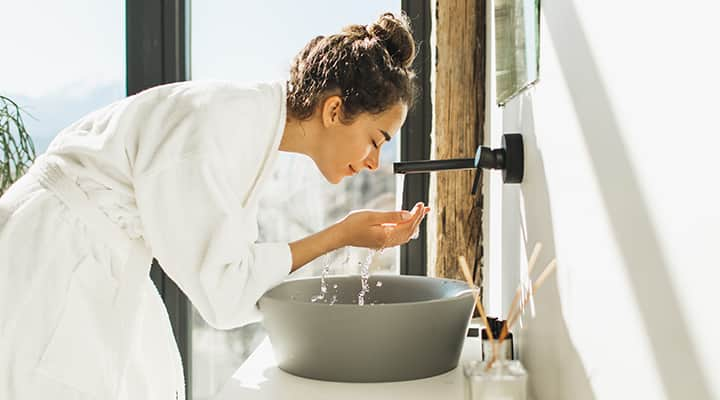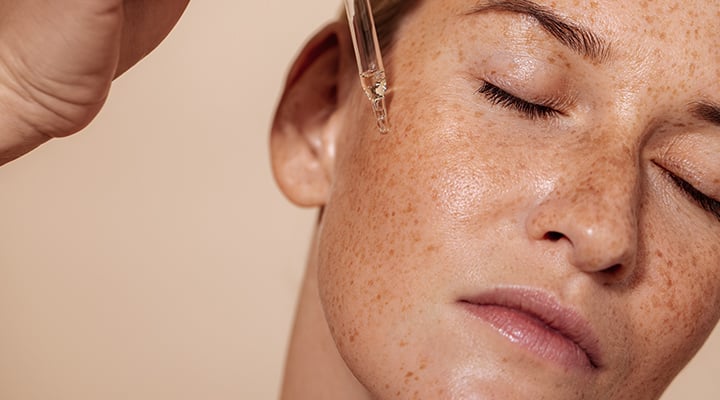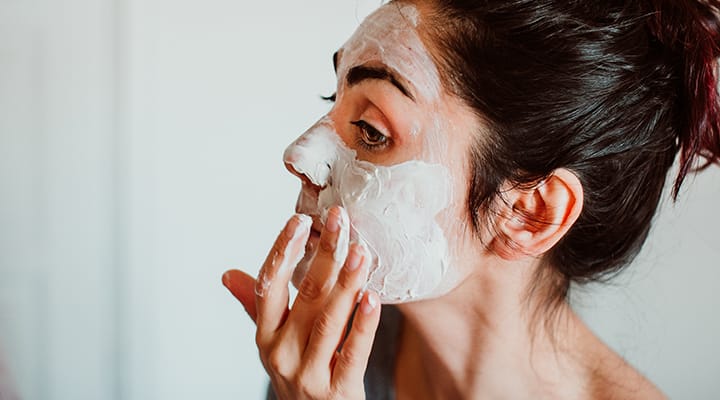
Build Your Own Skin Care Routine
Published: January 2023
Let’s face it: building your own skin care routine can be challenging. Between cleansers, exfoliators, serums, oils, ceramides, creams and moisturizers—how do you know what to choose, where to start and what to do when?
The answer, of course, is not to put all of these products on the delicate skin of your face all at the same time. This is particularly important if you are over 40 and your goal is anti-aging; too much of a good thing can be, well, bad!
So how do you know which products you need, when to apply them, and how often? It starts with understanding your skin type and challenges. Once you identify what your skin needs are and get a better understanding of these different products, you’ll find creating a skin care routine isn’t as difficult as it may seem.
And because skin care is self-care, enjoy our DIY Greek yogurt face mask recipe to give your skin the extra pampering it deserves.
Why your skin care routine matters
Many people think having beautiful skin is all about your DNA. The truth? Research suggests the skin’s appearance is about 60 percent genetics and 40 percent environmental factors. So, the daily habits we do to care for our skin that sustain our daytime and nighttime routine can have a significant impact on overall skin health and complexion.
According to Dr. Crystal Gossard, Life Extension’s Education Specialist, how your skin looks and feels depends on the health and function of three structural proteins:
- Keratin
- Collagen
- Elastin
These proteins are the building blocks for skin, hair and nails. Over time, they change and lead to the telltale signs of normal aging, including the appearance of fine lines, wrinkles and dry skin. External factors from your environment can also take their toll.
High-quality skin formulas replenish and support production and function of these proteins without negatively impacting your skin. The right skin care products and routine encourage these effects, producing a beautiful complexion others will assume is the result of “lucky genes” alone.
How do I start a skin care routine?
Almost any skin care routine includes the following steps:
- Cleanser—Helps wash your face and remove dirt, oils and other things that may come in contact with your skin
- Exfoliate—Helps scrub away impurities, debris and dead skin cells, leaving skin looking clear and feeling fresh.
- Serum—Provides the benefit of more active ingredients—such as antioxidants
- Moisturizer—Hydrates and softens the skin
But, this can get complicated. Because there are so many different types of products for your skin, using the wrong product at any step can affect the skin on your face and neck.
That’s why it’s so critical to first understand your complexion, said Dr. Gossard, noting that “identifying your skin type will help you incorporate an individualized approach.”
How do I know my skin type?
An easy way to discover your skin type is identifying how your skin feels after you wash it. Focus on whether your skin feels normal, dry or oily after you’ve washed and dried your face. If you notice your face feels normal in some areas and oily, dry or sensitive in others, it’s an indication that you may have combination skin.
| Skin type | Characteristics |
|---|---|
| Combination |
|
| Oily |
|
| Dry |
|
Your step-by-step skin care routine
1. Cleanser
A facial cleanser removes dead skin cells, dirt and debris from your skin. When cleansing, make circles over your face using your fingertips, then rinse and pat dry. The key here is to be gentle. Here’s which cleanser will be best suited to your skin type.
| Skin type | Cleanser | How it works |
|---|---|---|
| Combination | Micellar water cleanser |
|
| Oily | Foaming/gel cleanser |
|
| Dry | Micellar water |
|
While this list is a guide, your skin is the ultimate test. It’s crucial to pay attention to how your skin feels when you use your cleanser. Dr. Gossard also recommends using an exfoliant once a week to remove accumulated dead skin cells and refresh your skin’s appearance.
2. Exfoliator
After cleansing your skin, exfoliating is a must. It will help buff away dirt, debris and dead skin cells, leaving a clean and fresh complexion.
Exfoliating tips
| Skin type | How to exfoliate |
|---|---|
| Combination |
|
| Oily |
|
| Dry |
|
Pro tip: Choose exfoliators that also have soothing ingredients like seaweed, calming essential oils and peppermint oil extract. These ingredients will help smooth and hydrate the skin after removing dirt and debris.
3. Serum
Applied after cleansing and exfoliating, serums prepare your skin to better absorb the moisturizers and other products you use. (Just remember not to mix serum in with your moisturizer—they’re separate steps for a reason!)
From hyaluronic acid, which supports smooth-feeling skin, to ceramides for hydration, and even antioxidant rich vitamins B3, C and E, there are several common ingredients that you should look for when choosing a serum.
You can follow this guide, but ultimately, you want to look for serums that target skin-specific needs based on their ingredients and your skin type.
| Skin type | Serum ingredients | What they do |
|---|---|---|
| Combination |
|
|
| Oily |
|
|
| Dry |
|
|
Pro tip: All of these ingredients also promote antioxidant protection, a key component of healthy skin!
4. Moisturizer
The final step in a basic skin care routine is moisturizer. It encourages water retention in the outer layers of the skin. Applying a moisturizer also helps lock in the benefits of the other products you use in your skin care routine.
- Look for daytime moisturizers that promote antioxidant protection. And remember to protect your skin by applying an SPF rated sunscreen when you enjoy the outdoors.
- Choose a nighttime moisturizer that stimulates and encourages the renewal and revitalization process that cells naturally go through at night.
| Skin type | Moisturizer |
|---|---|
| Combination | Lotion. You can also use an oil-free moisturizer on your T-zone, and a cream on your U-zone (cheeks, jaws and chin) |
| Oily | Gel and water-based moisturizers |
| Dry | Creams and oil-based moisturizers |
Pro tip: While it’s an optional part of a skin care routine, using an eye cream is a great way to ensure this delicate area stays moisturized. It can also help you target specific needs such as puffiness, dryness or dark circles.
Explore Our Best Skin Care Products
Three types of moisturizers
When you shop for moisturizing formulas, make sure you choose ingredients in these three categories:
- Humectants—Attract and retain water to the outer layer of the skin. They include hyaluronic acid, glycerin, alpha hydroxy acids (lactic acid), sugars, glycol, glycerol and sorbitol, amino acids, honey, aloe vera gel.
- Emollients—Fill in spaces between skin cells with droplets of oil. They include stearic acid, coconut oil, vitamin E, cholesterol.
- Occlusives—They form a water-trapping layer on the skin’s surface and help block water loss. Mineral oil, lanolin, silicones, zinc oxide.
Beautiful skin, day and night
This step-by-step routine—cleanse, exfoliate, apply serum, moisturize—should be repeated AM and PM, but there are some differences based on whether you’re about to face a new day…or hit the hay. You’ll notice many products are labeled for either evening or day use.
“During the day, you are exposed to environmental factors,” Dr. Gossard explained. “Daytime formulas are usually lighter and promote antioxidant protection.”
Nighttime creams, on the other hand, are typically heavier and more hydrating, with advanced formulas containing ingredients such as melatonin and dimethylaminoethanol (DMAE) to “reinforce the skin’s capacity for renewal and revitalization during the night.”
Good Digestion Can Mean a Good Complexion
Consuming fatty, sugary and processed foods can affect the health of the microbiota in the digestive tract, major contributors to digestion, nutrient intake and immune response.
Instead, pile your plate high with antioxidant-rich foods, healthy fats, probiotics, proteins, and veggies and leafy greens. These foods support the health and function of your gut bacteria, which results in a chain-reaction of goodness for your skin and whole-body health—not to mention smooth, vibrant and plump-looking skin.
DIY Greek Yogurt Face Mask
A good skin care routine is a lot of work. Reward your efforts and further your skin care goals by indulging in a face mask. You’ll enjoy how the mask feels and the end result will be facial-fresh skin without the expense of a spa day.
We recommend this Greek yogurt mask recipe because yogurt contains probiotics, beneficial bacteria that are thought to help maintain the skin’s flora and support its youthful appearance.
Be sure to read the label before buying your favorite Greek yogurt brand to avoid additives, and steer clear of sugary flavors. Greek plain yogurt is a great choice because the thicker consistency will stop it from dripping down your face—a sensation bound to disturb any home spa experience!
Greek Yogurt and Honey Recipe
Ingredients:
1 T organic plain Greek yogurt
1 ½ T organic honey
Optional mix-ins:
Turmeric
Aloe vera
Lemon juice
Instructions:
- Cleanse your face and neck.
- Add Greek yogurt and honey to a small bowl.
- Mix until you get an even blend.
- Apply a thin layer to face, neck and décolleté (upper chest and shoulders).
- Set a timer for 15 minutes or until mask is fully dried.
- Gently remove your mask with lukewarm water and circular motions. Once you’ve completely removed your mask, pat it dry with a clean towel.
- Continue with the next step on your skin care routine.
Pro tip: Romanticize your “me time.” After applying your Greek Yogurt facemask (and set the timer), light some candles, set up your favorite playlist on Spotify, and take this time to unwind and relax after a taxing day…or week!
Other ways to support healthy skin
Aging is a natural process that no one can avoid. Building your own skin care routine and tailoring it to your skin type is the best way to keep your skin beautiful, healthy and vibrant looking.
“Self-care may feel like it’s all about you, but the reality is, when we take care of ourselves, we are better equipped to help others. It involves caring for your mind, body and soul every day,” explained Dr. Gossard.
Remember that an active lifestyle, as well as a healthy diet and restful sleep, are also major contributors to how your skin looks and feels.
Being consistent and patient will yield the best results—it’s not a race, it’s about making healthy choices and creating sustainable habits that encourage you to feel and be your best.
References
- Kim, Sooyoung, et al. “A consistent skin care regimen leads to objective and subjective improvements in dry human skin: investigator-blinded randomized clinical trial.” J Dermatolog Treat. February 2022. https://pubmed.ncbi.nlm.nih.gov/32239984/
- Kober, Mary-Margaret and Whitney P. Bowe. “The Effects of Probiotics on Immune Regulation, Acne, and Photoaging.” Int J Women’s Dermatol. June 2015. https://www.ncbi.nlm.nih.gov/pmc/articles/PMC5418745/
- Zhang, Lixia, et al. “The Impact of Routine Skin Care on the Quality of Life.” Cosmetics. July 2020. https://www.mdpi.com/2079-9284/7/3/59/htm
- “How to Care for Your Skin in Your 60s and 70s.” American Academy of Dermatology Association. https://www.aad.org/public/everyday-care/skin-care-basics/care/skin-care-in-your-60s-and-70s
- “Tips for Healthier Skin as You Age.” National Institute on Aging. https://www.nia.nih.gov/health/infographics/tips-healthier-skin-you-age
- “Why Yogurt Isn’t Only Good for Your Gut But Also for Your Skin.” Dermstore. https://www.dermstore.com/blog/top_ten/yogurt-skin-benefits/
Like what you read?
Please subscribe to get email updates on this blog.









